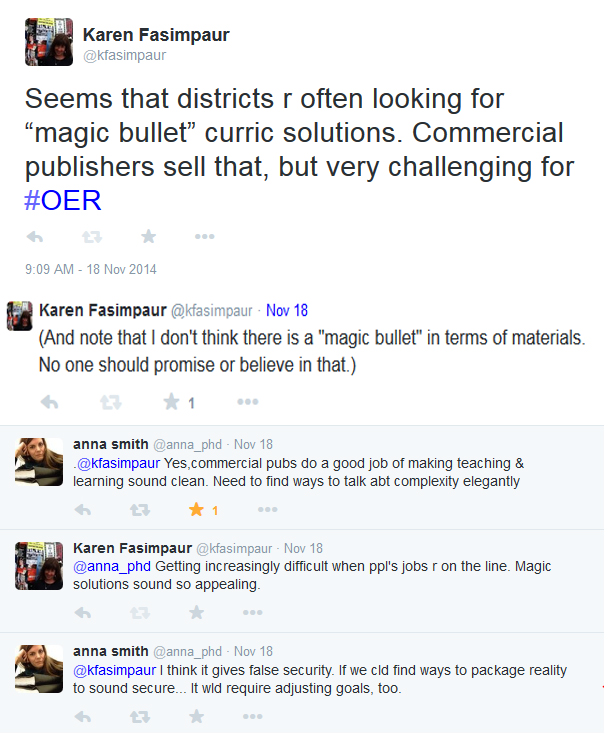A few us have been pondering the question “How can we best advance the adoption of OER in K-12?” both online in this document and f2f at the Open Ed 14 conference.
As I’ve thought about this, a few conclusions I’ve come to are:
- The demand problem is more significant than the supply problem.
There is currently a good amount of high quality, standards-aligned OER in K-12 with lots more coming online. For the most part, this supply is not being used as much as it could/should be. - The most challenging point in the adoption decision chain is at the district level.
K-12 adoption is a complicated process with decisions made at the state, district, and classroom teacher level. With regards to OER, many states have approved, recommended, and/or endorsed the use of OER. Similarly, most classroom teachers who know about OER think it is useful for their classrooms. With rare exception, though, districts have not adopted OER over similar commercial curricula.
The reasons for this are many. One is that commercial publishers spend a great deal of resources to support the adoption decision that OER publishers simply cannot match. A commercial purchase generates to significant profits to do things like court the district, make numerous pre-sale presentations, provide professional development, provide ongoing support, etc. This is nearly impossible for OER to do. - OER is not an “easy” decision for districts to make.
This point has been made to be my numerous educational leaders. On the one hand, it is the “no one-ever-got-fired-for-buying-IBM” effect, but there’s more to it than that.
As the below twitter exchange demonstrates, commercial publishers are willing to make silver bullet claims that OER cannot make. Of course, I and many others would maintain that no curriculum can guarantee academic achievement improvements (and in fact, I don’t think instructional resources are even the primary factor in determining achievement), but that is the promise that commercial publishers make. I don’t think OER can or should make this claim (though some in the OER movement seem to be going in that direction), but this is a key reason that it is very difficult for districts to choose OER.
So how do we answer the question “What are the highest leverage points through which K-12 OER use might be advanced?” It seems to me that there are two very different paths that we might take.
The first is to work harder on packaging an OER solution that better matches up to commercially published product. This may involve talking about the complexity of teaching and learning more elegantly as suggested above. It almost certainly needs to include a sales and support process for OER. It may require production of a glitzy line of ancillary products. It is likely an expensive proposition.
The second is to choose to compete less directly with commercial products and instead target those who are already disillusioned with the existing commercial approach to school. Focus more on open pedagogy. Empower teachers and learners more by building agency.
While this second approach is more appealing to me personally, I am not sure it will lead to more “mainstream adoption” in today’s educational environment. I suspect that those who are moving in this direction are already doing so, though OER might provide them with more tools to do so.
I hope that the tide in education turns so that the mainstream supports what many of us believe is a better learning environment.

